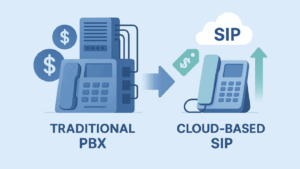
Do You Need SIP Trunk Encryption?
SIP trunking is a telecommunications technology that companies increasingly utilize to replace traditional telecommunication systems. However, SIP trunking isn’t inherently secure by design and can pose significant security risks. One solution to overcome this drawback is to deploy SIP trunk encryption to make VoIP communications over SIP trunks more secure.
As the VoIP market as a whole is rapidly growing, with an expected CAGR of 15 percent from 2021 to 2027, the need for SIP trunk encryption will only continue to grow as well. However, SIP trunking does not come without its security risks despite this rapid growth.
That’s why moving forward, businesses that want to switch to SIP trunking or are already utilizing it need to understand the risks associated with it entirely. Without the proper SIP trunking encryption protocols, an organization is liable to attackers gaining unauthorized access to their sensitive communications data. Such scenarios may lead to further disastrous consequences, including data breaches and additional cyberattacks.
What Is SIP Trunk Encryption?
To understand SIP trunk encryption, it first helps to understand what SIP trunking is and how it works fully.
Session Initiation Protocol (SIP) trunking is a service that communications service providers utilize to provide online communication to their customers. SIP trunking accomplishes this by combining the Voice over Internet Protocol (VoIP) with the Session Initiation Protocol (SIP).
The difference between SIP trunking and traditional telecommunications systems is the technology both utilize to accomplish voice communications. For example, a typical telephone network consists of a Private Branch Exchange (PBX) system for call management and services such as voicemail. The PBX connects to the Public Switched Telephone Network (PSTN) through Primary Rate Interface (PRI) lines. By contrast, SIP trunking uses IP-enabled PBX for internet connectivity and connects to a data network rather than the PRI lines.
SIP trunk encryption is thus the method for securing communications over a SIP network through end-to-end encryption. Once the communication is encrypted, the organization significantly improves its communications security and can protect sensitive data in transit.
Related: SIP Trunk PBX and VoIP: What Are They and How Do They Work?
Why Use SIP Trunk Encryption?
Although not many may have heard of SIP trunking, the chances are that your organization is already familiar with it. That’s because VoIP services ranging from Apple FaceTime to Facebook Messenger and even WhatsApp are already using SIP trunking for their VoIP services.
Despite its widespread usage, traditional trunking methods may be insecure without the proper encryption protocols in place. Although most SIP trunking service providers encrypt their trunking services by default, trunking security is a two-sided process. The service provider’s encryption is just one side of the coin, the other being the user encrypting their end of the communication service. If there is a security flaw at either end of the trunking process, the overall communication may be at risk.
SIP Trunking can therefore help secure communications at both ends of the service, from the trunking provider’s end to that of the user.
How Is SIP Trunking Unsafe?
The SIP trunking process consists of three major steps. In the first step, a user places a call over a SIP network, and the SIP service contacts the recipient. The next step involves other communication protocols that carry the call’s contents from the sender to the recipient. Finally, once the call terminates, the SIP protocol takes over again and terminates it.
At first glance, this may not seem like much of a security risk. However, the problem arises once we go deeper into the nature of SIP as a protocol.
SIP is a text-based communications protocol, not too different from the commonly used HyperText Markup Language (HTML), the building block of the world wide web. Part of this similarity also includes a similar addressing system, which closely resembles that of one found in the Simple Mail Transfer Protocol (SMTP). The addressing system contains a header that contains sensitive private information. This information may include the caller’s identity, device information, and private contact details.
As SIP trunking uses internet servers to carry this information, attackers can reach these servers and intercept the communication. In addition, as the information travels over plain text, anyone listening to the communications can intercept and access this information.
What Are Some Common SIP Attacks?
SIP Trunking is commonly associated with several SIP cyberattacks, such as the registration hijacking assault. This attack is a type of cyberattack where an attacker can deactivate a user’s SIP registration and replace it with the attacker’s logical address.
Due to its similarities with publicly available internet services such as HTTP, communications that use SIP trunking are also vulnerable to similar attacks, including:
- Buffer overflow attacks
- SQL injection attacks
- DDoS attacks
- Hijacking/Man-in-the-middle attacks
Not all of these attacks are directly related to SIP trunking encryption. For instance, DDoS attacks are virtually impossible to execute without accessing the target network.
That said, attack methods such as man-in-the-middle attacks are made possible through unencrypted communications. Even if both the SIP trunking service provider and the client encrypt the connections from their end, the data traveling over the internet is still visible in plain text. As such, if an attacker successfully hijacks part of your communication’s call path and extracts call data, they can do with it as they please if the data is unencrypted. Therefore, the solution against such attacks is to encrypt your data while it is in transit.
How Do I Ensure SIP Trunking Encryption?
The best way to ensure that your communications are secure is to choose a SIP trunking provider that enforces SIP trunking encryption by default.
Specifically, you should ensure that your provider helps secure your data over both layers of the SIP connection:
- The Data Layer is the layer that contains your SIP connection information and stores it in data packets. The information includes details such as the IP address for the PBX system in use and the connected devices.
- The Audio Layer is the layer containing the actual audio contents of the communications (i.e., the phone conversation itself). The system stores this audio in a set of audio packets.
Securing both layers will guarantee that your communications are safe both from the service provider and users’ end, as well as in transit over an internet server. Your goal, therefore, should be to find a SIP trunking service provider that encrypts both SIP communication layers.
Related: How Having a Good VoIP and SIP Gateway Provider Facilitates Smoother Communication
SIP Trunking Encryption Methods
Two recommended SIP trunking encryption protocols that guarantee communications security over both layers include:
- Transport Layer Security (TLS) for securing the data layer.
- Secure Real-Time Transport Protocol (SRTP) for securing the audio layer.
Additionally, using Virtual Private Networks (VPN) and IPSec tunnels can add an extra layer of security for ensuring SIP communication sessions remain private.
Choose The Best SIP Trunking Service Provider
Although SIP trunking shows great promise as a low-cost alternative to traditional telephone networks, it still carries significant security risks. Organizations not aware of these risks can potentially expose their sensitive VoIP communications and become vulnerable to cyberattacks.
You should now be better informed of the risks of SIP trunking, why they arise in the first place, and how SIP trunk encryption can protect you against them. The next step to protect your organization’s communications is to look for a service provider that not only provides the best SIP trunking service but guarantees communications security by enforcing the most secure SIP trunk encryption protocols.
Get started with SIP.US today to keep your VoIP communications secure and encrypted, no matter the scale of your organization. SIP.US offers trunking for IP-PBX and analog/digital gateways and provides clients with an online control panel to easily manage and secure their SIP trunks.


